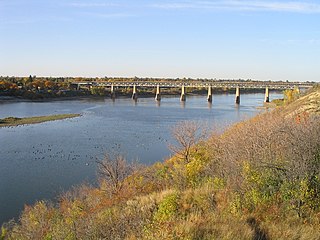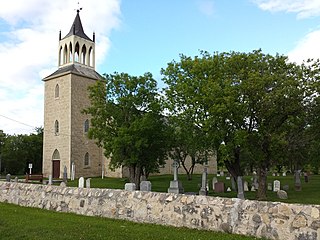The Cree are a North American Indigenous people. They live primarily in Canada, where they form one of that country's largest First Nations.

The Rural Municipality of Gimli is a rural municipality located in the Interlake Region of south-central Manitoba, Canada, on the western shore of Lake Winnipeg. It is about 75 kilometres (47 mi) north of the provincial capital Winnipeg. The rural municipality's population in the 2016 Canadian Census was 6,181, making it the 12th largest rural municipality by population. The RM of Gimli has an area of 318.75 square kilometres (123.07 sq mi), making it the sixth smallest rural municipality by area.

Lake of the Woods is a lake occupying parts of the Canadian provinces Ontario and Manitoba along with the U.S. state of Minnesota. Lake of the Woods is over 70 miles (110 km) long and wide, containing more than 14,552 islands and 65,000 miles (105,000 km) of shoreline. It is fed by the Rainy River, Shoal Lake, Kakagi Lake and other smaller rivers. The lake drains into the Winnipeg River and then into Lake Winnipeg. Ultimately, its outflow goes north through the Nelson River to Hudson Bay.

The Saskatchewan River is a major river in Canada, about 550 kilometres (340 mi) long, flowing roughly eastward across Saskatchewan and Manitoba to empty into Lake Winnipeg. Through its tributaries the North Saskatchewan and South Saskatchewan, its watershed encompasses much of the prairie regions of central Canada, stretching westward to the Rocky Mountains in Alberta and north-western Montana in the United States. It reaches 1,939 kilometres (1,205 mi) to its farthest headwaters on the Bow River, a tributary of the South Saskatchewan in Alberta.
Emerson is an unincorporated community recognized as a local urban district in south central Manitoba, Canada, located within the Municipality of Emerson – Franklin. It has a population of 678 as of the 2016 Canada census.

Morris is a small town in the Pembina Valley region of Manitoba, Canada, located 51 km south of Winnipeg and 42 km north of Emerson. Morris is home to 1,885 people (2016). Named after Alexander Morris, the second Lieutenant Governor of Manitoba.

St. Andrews is a rural municipality in Manitoba, Canada. It lies west Red River; its southern border is approximately 8 kilometres (5.0 mi) north of Winnipeg.

The SS Keenora is a steamboat on Lake Winnipeg. The vessel began operations on Lake of the Woods in Ontario, where from she was transported to Winnipeg, Manitoba and rebuilt. Currently retired from service, Keenora is the centrepiece of collection at the Marine Museum of Manitoba in Selkirk, Manitoba.
Treaty 2 was entered in to on 21 August 1871 at Manitoba House, Rupertsland, with representatives of the Queen of Great Britain and Ireland. The original Anishinaabe, who were present, constitute Treaty 2 today. It is known that many of the chiefs and leaders within the territory were at the early gathering and after the treaty was agreed to. Those who were not present were represented through Metis until they indicated where they wished their farming reserves to be established. The treaty reaffirmed the inherent rights that the Anishinaabe had prior to European contact, located where southwestern Manitoba is today and a small part of southeastern Saskatchewan.

Lorette is a local urban district in the Rural Municipality of Taché, located 25 km southeast of Winnipeg, in the province of Manitoba, Canada.
The Warren Landing Upper Range Lights are a pair of range lights in Warren Landing, Manitoba at the entrance to the Nelson River. Built in 1908, the lighthouses help to guide ship traffic from Lake Winnipeg into the river. They work in tandem with the Warren Landing Lower Range Lights.
The Warren Landing Lower Range Lights are a pair of range lights in Warren Landing, Manitoba, at the entrance to the Nelson River. Built in 1908, the lighthouses help to guide ship traffic from Lake Winnipeg into the river. They work in tandem with the Warren Landing Upper Range Lights.
South Indian Lake is an Indian settlement located on the southeast shore of Southern Indian Lake in northern Manitoba, Canada, about 130 km (81 mi) north of the city of Thompson by air. It had a population of 981 in 2016, and is the main settlement of the O-Pipon-Na-Piwin Cree Nation, a First Nations band government.

The geography of Manitoba addresses the easternmost of the three prairie Canadian provinces, located in the longitudinal centre of Canada. Manitoba borders on Saskatchewan to the west, Ontario to the east, Nunavut to the north, and the American states of North Dakota and Minnesota to the south. Although the border with Saskatchewan appears straight on large-scale maps, it actually has many right-angle corners that give the appearance of a slanted line. In elevation, Manitoba ranges from sea level on Hudson Bay to 2727 ft (831 m) on top of Baldy Mountain. The northern sixty percent of the province is on the Canadian Shield. The northernmost regions of Manitoba lie permafrost, and a section of tundra bordering Hudson Bay.

The history of Manitoba covers the period from the arrival of Paleo-Indians thousands of years ago to the present day. When European fur traders first travelled to the area present-day Manitoba, they developed trade networks with several First Nations. European fur traders in the area during the late-17th century, with the French under Pierre Gaultier de Varennes, sieur de La Vérendrye set up several trading post forts. In 1670, Britain declared sovereignty over the watershed of Hudson's Bay, known as Rupert's Land; with the Hudson's Bay Company granted a commercial monopoly over the territory.
The Sayisi Dene are Chipewyan peoples, a Dene group, living in northern Manitoba. They are members of the Sayisi Dene First Nation, located at Tadoule Lake, and are notable for living a nomadic caribou-hunting and gathering existence. They are the most eastern of all the Dene peoples.
Brokenhead Ojibway Nation (BON) is an Anishinaabe (Saulteaux/Ojibwa) First Nation located approximately 64 kilometres (40 mi) northeast of Winnipeg, Manitoba.
Berens River First Nation is a First Nations band government in Manitoba, Canada. The First Nation has two reserves: Berens River 13 and Pigeon River 13A, located in the boreal forest east of Lake Winnipeg. The First Nation is governed by a chief and five councillors.
The Old Dawson Trail is the remnant of the first all-Canadian route that linked the Great Lakes with the Canadian prairies. It was a water and land route that began at Port Arthur, Ontario and ended at St. Boniface, Manitoba. The land portions of the trail are usually referred to as Dawson Road.
Hnausa Beach Provincial Park is a Manitoba provincial park on the west shore of Lake Winnipeg north of Gimli, Manitoba. The beach within the park is named after the nearby community of Hnausa. Hnausa is an Old Icelandic word for a piece of turf. This part of Manitoba is known as New Iceland due to the significant Icelandic settlement of the area that began in 1875.









